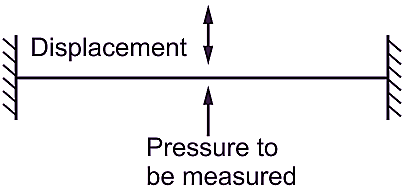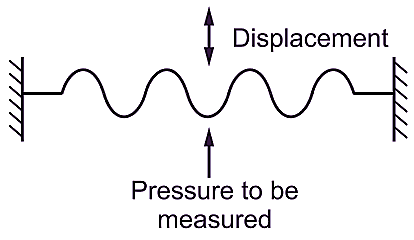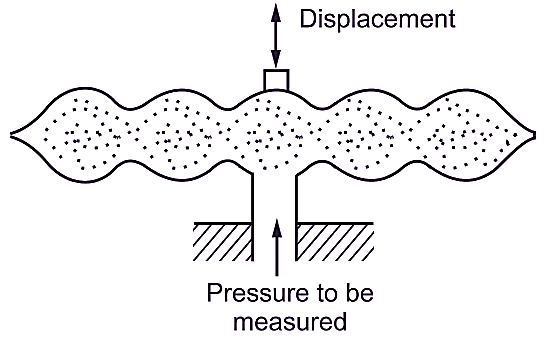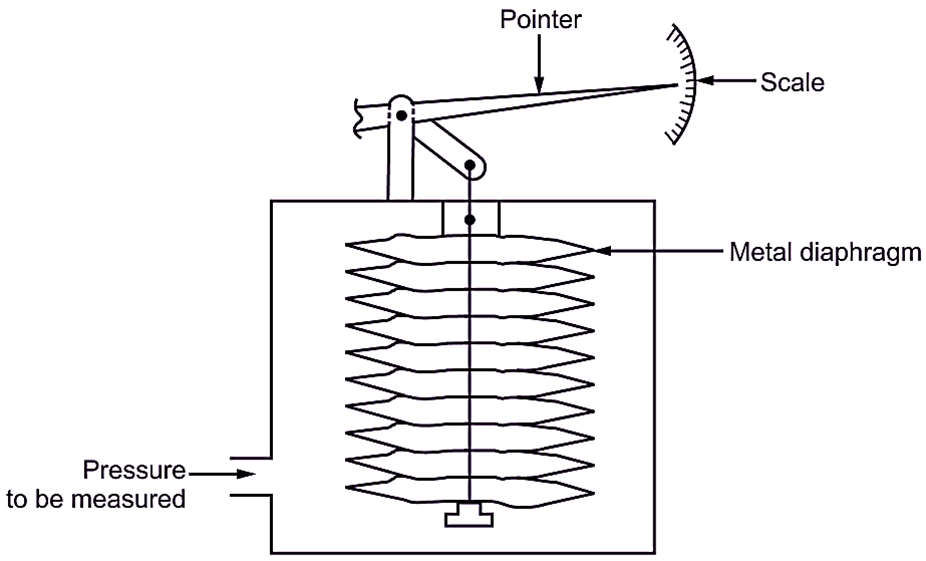The diaphragm is a thin plate of circular shape clamped firmly around its periphery. Also, it can be called as very thin membrane under radial tension.
Working Principle of Diaphragm Gauge
Diaphragm gets deflected towards the low pressure applied (because of pressure difference) and this deflection produced is directly proportional (straight line relationship) to the applied pressure.
Uses:
- For low pressure range measurement due to its ability to detect very small pressure variations.
- As Capacitive or Inductive transducer, which produces the electrical output proportional to the pressure measured.
Important Points:
- No need of spring: The deflection produced by diaphragm is small; therefore, it does not require spring as in case of bellow.
- Unsuitability: The pressure measurement by diaphragm is limited to low-pressure range, because of its design, manufacturing and material used. Therefore, it is not suitable for very high pressure measurements.
- Movement of diaphragm: It depends on the,
(a) Applied pressure, and
(b) Thickness of diaphragm, and
(c) Diameter of diaphragm.
Diaphragm Shapes
The diaphragms may be in the form of flat, corrugated, capsule etc. Selection of shape depends upon the strength and amount of deflection desired.
Flat type
This can be used as primary or secondary transducer. The deflection of flat diaphragm is limited to 30

Fig. 1: Flat Diaphragm
Corrugated type
In order to increase the displacement of flat diaphragm, corrugation is provided on its surface and is known as corrugated diaphragm. The corrugation can be made in different forms. Corrugated diaphragm permits increased deflection without stresses.

Fig. 2: Corrugated Diaphragm
Capsules
The diaphragm element used for pressure measurement may consist of single disc or it may be bonded together at their circumference. The bonding (joining) may be done by soldering or suitable pressure welding to form capsule. The set of capsules joined together depends upon the range of pressure measurement. The total deflection is the sum of deflection of all capsules

Fig. 3: Capsules
Types of Diaphragm Element Design
There are two basic types of diaphragm element design.
Metallic diaphragm gauge
Metallic diaphragm gauge consists of corrugated or flat plate flexible diaphragm depending on the deflection desired.

Fig. 4: Metallic Diaphragm Gauge.
It is made from a full hard, cold rolled nickel, chromium or iron alloy, which have elastic limit of 560 MN/m2. Operation of Metallic diaphragm depends upon its own resilience. A pointer is attached to the diaphragm. The applied pressure causes deflection of the diaphragm. The motion of the diaphragm operates an indicating or recording type display device or output read-out device. Pressure range: 125 mm of water gauge to 1.05 MN/m2 with an accuracy of 0.5 to 1
Applications:
- Used as low-pressure absolute pressure gauges, liquid level gauges.
- Used in many types of recorders and controllers operating in the low range of direct or differential pressures.
- Used for pressure measurement in moving objects like aeroplanes due to capability of working in any horizontal or vertical position.
Non-metallic diaphragm or slack diaphragm
The non-metallic diaphragm employs a soft and flexible material with no elastic characteristics. It is made up of materials like animal membranes, silk clothes etc. and synthetic materials like Teflon, Neoprene, Polythene etc. The movement of the diaphragm is opposed by a spring, which determines the deflection for a given pressure.
Application of Diaphragm gauges
- It is used for indication of the boiler draught in a chimney stack.
Advantages of Diaphragm gauges
- Small size and moderate cost.
- Capability to withstand high pressures.
- Good linearity over a wide range of pressures.
- Available for absolute and differential pressure measurement.
- Low hysteresis and no permanent zero drift.
Disadvantages of Diaphragm gauges
- They need protection from shocks and vibrations.
- Difficult to repair.
- Not suitable for very high-pressure measurements.